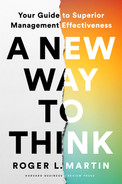Afterword
I hope that this book has got you thinking—or, more accurately, rethinking. You will probably have experienced the sting of these dominant models failing you—not all fourteen but probably more than a few. I hope I have convinced you that you should stop blaming yourself for having applied the model poorly. Chances are that it wasn’t your fault—it was the model’s fault.
I don’t expect you to completely adopt the alternative model that I have presented in each chapter based on my argument. But I do hope that you give the alternative model a try. That is how you will move ahead and learn. You won’t learn by continuing to reapply the flawed model and experience its ineffectiveness; you will simply reconfirm that it doesn’t deliver. It’s by trying models, observing the results, and then experimenting with a new model when the promised results don’t materialize that you will embark on a positive learning journey.
And as you progress on that journey, keep in mind that you’re the boss: you own your models. If you keep blaming yourself for the failure of the model that you are using yet keep on trying to use that model more effectively, then your model owns you. It is as if you have conferred it a monopoly on the use of your brain. If, instead, you hold your model accountable for producing the results that it promises and jettisoning it when it comes up short in repeated trials, then you own your models. If they don’t perform for you, toss them out.
Of course, you should give the existing model a fair chance of working. Models don’t become dominant for no reason. But I would encourage a healthy impatience. A model is a form of promise: if you use me, I will produce the following results for you. As with any product, if it fails conspicuously to fulfill its promise, you should not feel any obligation to keep buying it.
I am, however, realistic. I will go to my grave with some number of the models I propose not getting adopted more generally. Perhaps the one on which I’d give the longest odds is my approach to execution, described in chapter 10. My pessimism is based on two rather depressing recent conversations I have had around the idea—one with a scholar, among the world’s leading handful of management scholars; the other with a practitioner, the head of training and development for a prominent Bay Area tech company. In both cases we were talking about the frequently quoted saying that “a mediocre idea well executed is superior to a great idea poorly executed,” which both had used: the scholar in a tweet and the practitioner in a statement of company principles.
I asked each a fundamental question about the logic of their assertion: How would they know that an idea was “great” if it was “poorly executed”? You could well imagine how you would know if you had “a mediocre idea that was well executed.” The results would be as expected and would be mediocre. And you can well imagine how you would know that something was poorly executed. The results would be disappointingly worse than expected. But how would you know whether the idea behind it was great or not when the only thing that is observable is that the idea failed to deliver?
The practitioner had no answer. That is, she had no ideas on how she would judge whether the idea in question was “great.” When I asked her how she could support a principle of her company that “a mediocre idea well executed is superior to a great idea poorly executed” when she couldn’t even define what a great idea is, she said that it was an important principle to ensure action orientation. Unfortunately, it didn’t occur to her that the principle would guarantee an action orientation focused on mediocre ideas. Disappointingly, she showed zero interest in considering the viability or advisability of the model to which she dedicated herself.
The scholar, of course, had an answer. Scholars always have an answer. To him, the greatness of an idea should be judged by a panel of experts who opine on whether the idea is “novel” and “technically brilliant.” However, in the business context, “well executed” means commercially successful. When I pointed out that there is no known correlation between expert opinion on novelty or technical brilliance and commercial success, he simply restated the proposition in a different way: “Creativity is the potential of an idea, and execution is the extent to which that potential is realized.” Of course, there was no definition of potential or how it would be measured in his response. I gave up trying any further.
Clearly both the scholar and practitioner are owned by the model: “a mediocre idea well executed is superior to a great idea poorly executed.” And of course, both work away assiduously on the problem of why the execution of great ideas is so poor and on improvements to “execution practices.” I predict they will be working on that problem without progress for a long, long time.
My hope for you is that, unlike the scholar and practitioner, you will open your mind just a crack for each of the fourteen models. Imagine for a moment that a model the business world holds near and dear is, in fact, flawed and in response, experiment with a different model. If it doesn’t work better, I fully endorse you going back to the dominant model. But the more you and others test the fourteen alternative models, the further the practice of management will advance. By observing the results of their use, you will be able to see things that I haven’t seen and further advance the models, which will enhance the net effectiveness of management. And that is my purpose for writing this book.
